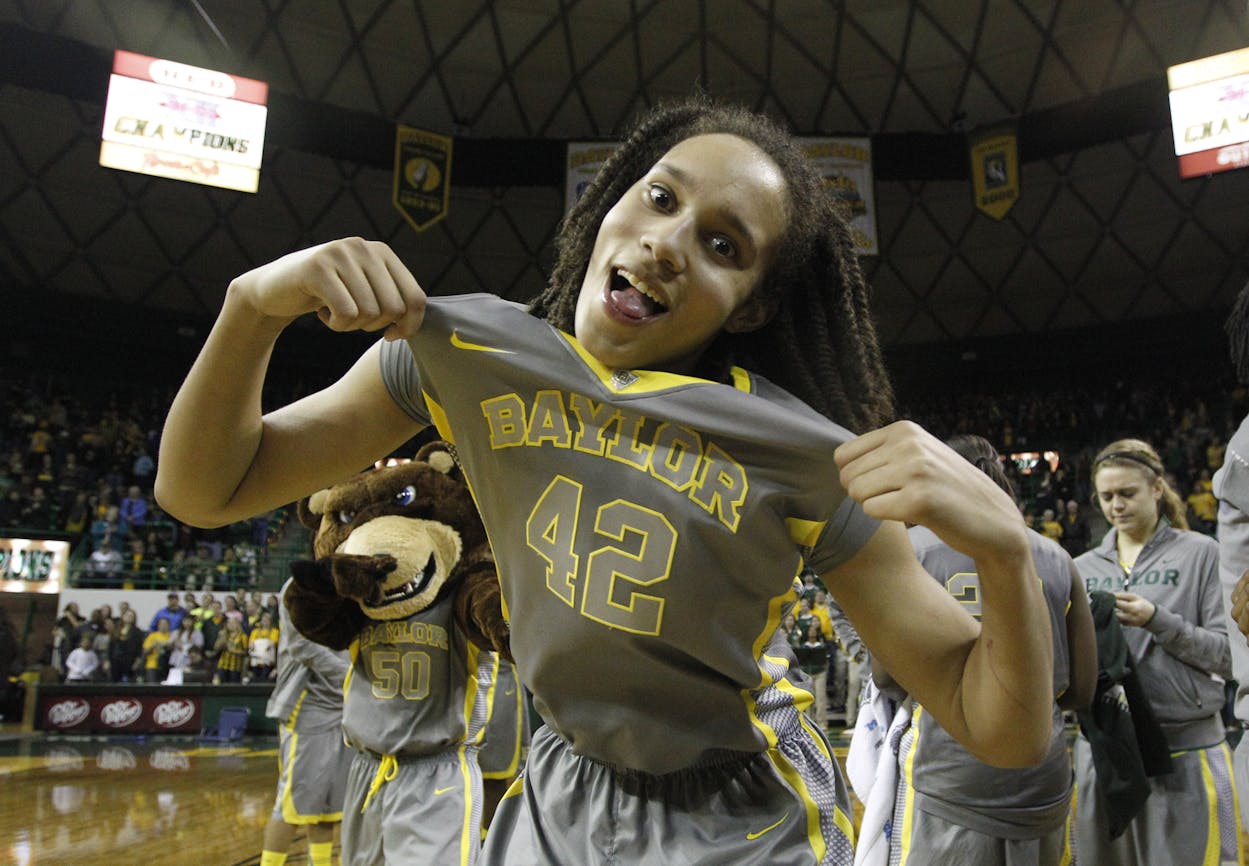The only thing bigger than Baylor University, it seems, is Linsanity.
The February 27 issue of Sports Illustrated has an impeccably crafted, approximately 7,000-word story about the Bears’ athletics program by S.L. Price, who is arguably the magazine’s preeminent long-form scribe. It’s the sort of major piece that surely would have been accompanied by the sight of either men’s basketball star Percy Jones III or women’s hoops icon Brittney Griner (above) at the supermarket check-out were it not for New York Knicks point guard Jeremy Lin, who made his second straight appearance on the cover of SI.
Price writes about how the Bears have recently dominated Texas college sports in ways no other Big 12 program has. Consider the following:
Football: The team had a season-ending win over UT, a Heisman Trophy for Robert Griffin III, and a wildly entertaining Alamo Bowl victory over the University of Washington.
Basketball: The men’s and women’s teams combined to go an unprecedented 40-0 between November 1, 2011 and January 16, 2012.
Other sports: Baylor has ten teams in the top 25.
In the classroom: Student athletes had an overall GPA of 3.17 in the fall semester.
Writes Price:
[Baylor]’s rise as a sports power is only the most obvious sign of a rare and far larger ambition. In 2001 university president Robert Sloan kicked off a $600 million master plan called Baylor 2012, which was dedicated to the proposition that a Baptist school can become an institution on a par with Cal or Stanford—and need not shed its faith to achieve national eminence.
The decision created a bitter campus divide. Baylor had lifted its ban on dancing only in 1996 and began to phase out a center dedicated to the study of intelligent design only in 2000; conservatives feared that Baylor 2012 meant the end of the university’s role as a Christian bulwark. But even as it upgraded the faculty, the administration continued to query prospective professors about their churchgoing habits—Muslim teachers need not apply, though Baylor currently has 131 Muslim students—and remained hostile to homosexuality. Sloan didn’t want Baylor to be Cal or Stanford. He had another school in mind.
Notre Dame has done it in the Catholic world,” says Larry Lyon, dean of Baylor’s graduate school. “And Catholics have over 1,000 years of intellectual history in which the church and philosophy and science coexisted. We don’t. Baptists have 200 years of anti-intellectualism: That’s our entire history. If Baylor does not become a great Protestant research university, there will never be one.”
Raising the school’s sports profile was one of the plan’s imperatives, vital for marketing and fund-raising.
Price goes on to explain how that once seemed to be a tough task, given the school’s past NCAA probations (in both the ’80s and ’90s), followed by what was probably the worst-ever scandal in college sports until last year’s Penn State child abuse allegations: the 2003 murder of Bears basketball player Patrick Dennehy by his teammate Carlton Dotson, followed by head coach Dave Bliss’s attempted cover-up.
The most poignant portion of the story is devoted to former Baylor hoops assistant Abar Rouse, the man whose secret tape recording of Bliss made him accountable. A Baylor alum, 36-year-old Rouse is all but blackballed from college athletics. “I’m the black sheep,” Rouse told Price. “I can’t go home, bro.”
Seen as disloyal at the time–he was publicly condemned by such big-name coaches as Duke’s Mike Kryszewski for violating locker-room omerta–Rouse served as a graduate assistant at Midwestern State in Wichita Falls (where he had previously worked) before leaving the game entirely. He’s currently a recreational specialist in a federal women’s prison, while Bliss is dean of students and head basketball coach at Allen Academy in Bryan.
Other highlights from Price’s feature:
- The school’s Heisman winner is referred to by most people around campus as “Robert.” (Apparently “RG3” is for the rest of us, outside the family).
- Associate history professor Thomas Kidd says Ken Starr, who became Baylor’s president in 2010, is enjoying “one of the longest honeymoons ever seen.”
- Price notes that many people in the game raise questions about men’s basketball coach Scott Drew’s recruiting tactics, and that there is a still-active NCAA investigation involving his former assistant Mark Morefield.
- Drew’s best quote about his team: “Now if people lose to Baylor, it’s not like they’re getting fired over it. It’s, well, That’s a good program.”
- Price gives women’s coach Kim Mulkey full (and fully-deserved) credit for the fact her program brought him to Waco in the first place: “Everything that’s happening in Waco—RG3 and PJIII and all this winning and love between town and gown—started with Mulkey, 49, and the Lady Bears,” he writes.
- Lyon, the graduate school dean, compares Waco’s Branch Davidian past with the Kennedy assassination. “For years Dallas was the place that killed the President, and now people [associate it with] the Cowboys or maybe the TV show Dallas,” he said “It never occurred to me that Baylor athletics might be the tool to redefine the community in a more positive way. But it has been.”
On top of the lengthy SI piece, on Sunday the New York Times published a similarly lengthy feature (at least by newspaper standards: close to 2,500 words) about Baylor sports. Greg Bishop’s story covers much of the same ground, with the added bonus of a Vitek’s Gut Pack reference, a quote from track star Michael Johnson and a denial by former Ann Richards chief of staff John Fainter that the governor had anything to do with easing Baylor’s path from the Southwest Conference to the Big 12 in 1996. Somehow the name “Bob Bullock” isn’t mentioned, though there is a quote from lobbyist and Baylor regent Buddy Jones:
We like to use biblical analogies, and this is a year of biblical proportions. As we would say in Christendom, it’s like an early rapture. We spent 40 years wandering the wilderness. I hope this is our exit.







